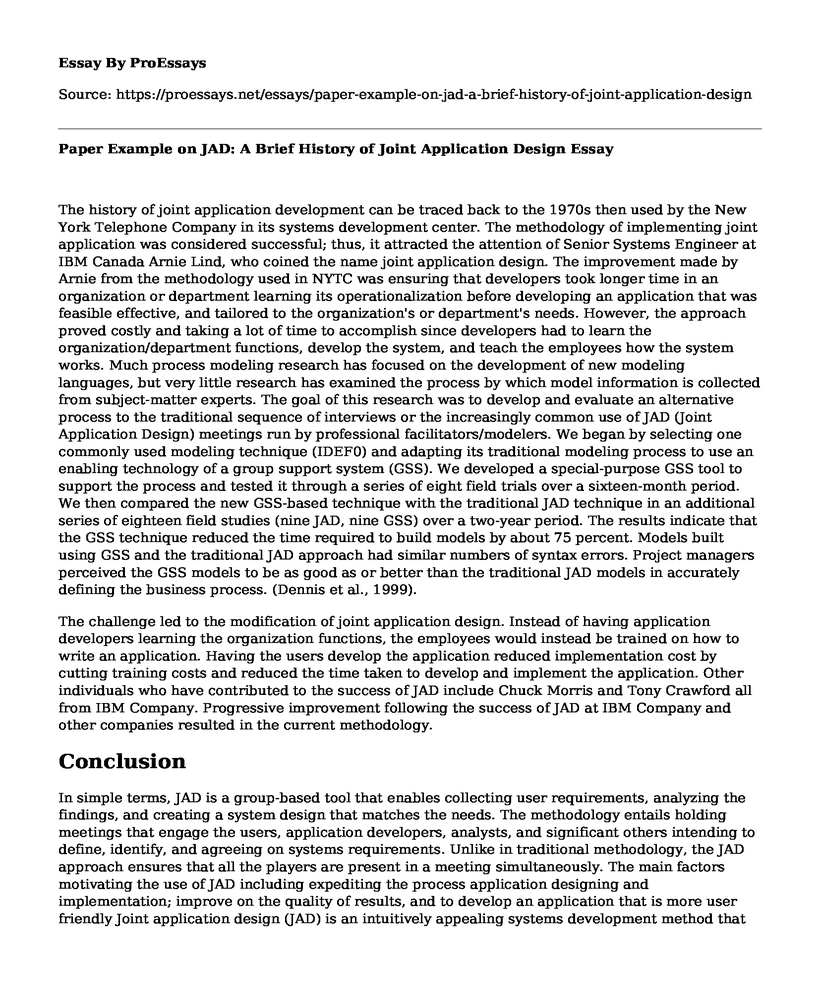The history of joint application development can be traced back to the 1970s then used by the New York Telephone Company in its systems development center. The methodology of implementing joint application was considered successful; thus, it attracted the attention of Senior Systems Engineer at IBM Canada Arnie Lind, who coined the name joint application design. The improvement made by Arnie from the methodology used in NYTC was ensuring that developers took longer time in an organization or department learning its operationalization before developing an application that was feasible effective, and tailored to the organization's or department's needs. However, the approach proved costly and taking a lot of time to accomplish since developers had to learn the organization/department functions, develop the system, and teach the employees how the system works. Much process modeling research has focused on the development of new modeling languages, but very little research has examined the process by which model information is collected from subject-matter experts. The goal of this research was to develop and evaluate an alternative process to the traditional sequence of interviews or the increasingly common use of JAD (Joint Application Design) meetings run by professional facilitators/modelers. We began by selecting one commonly used modeling technique (IDEF0) and adapting its traditional modeling process to use an enabling technology of a group support system (GSS). We developed a special-purpose GSS tool to support the process and tested it through a series of eight field trials over a sixteen-month period. We then compared the new GSS-based technique with the traditional JAD technique in an additional series of eighteen field studies (nine JAD, nine GSS) over a two-year period. The results indicate that the GSS technique reduced the time required to build models by about 75 percent. Models built using GSS and the traditional JAD approach had similar numbers of syntax errors. Project managers perceived the GSS models to be as good as or better than the traditional JAD models in accurately defining the business process. (Dennis et al., 1999).
The challenge led to the modification of joint application design. Instead of having application developers learning the organization functions, the employees would instead be trained on how to write an application. Having the users develop the application reduced implementation cost by cutting training costs and reduced the time taken to develop and implement the application. Other individuals who have contributed to the success of JAD include Chuck Morris and Tony Crawford all from IBM Company. Progressive improvement following the success of JAD at IBM Company and other companies resulted in the current methodology.
Conclusion
In simple terms, JAD is a group-based tool that enables collecting user requirements, analyzing the findings, and creating a system design that matches the needs. The methodology entails holding meetings that engage the users, application developers, analysts, and significant others intending to define, identify, and agreeing on systems requirements. Unlike in traditional methodology, the JAD approach ensures that all the players are present in a meeting simultaneously. The main factors motivating the use of JAD including expediting the process application designing and implementation; improve on the quality of results, and to develop an application that is more user friendly Joint application design (JAD) is an intuitively appealing systems development method that encompasses approaches for enhancing user participation, expediting development, and improving the quality of specifications. Although the JAD method has been widely acclaimed, little is actually known about its effectiveness in practice. This paper reports findings of a field study at three organizations in which JAD practices were examined to assess how practice influenced outcomes of JAD use. Findings suggest that the organizations realized modest improvements in systems development outcomes by using the JAD method. JAD use was most effective in small, clearly focused projects and less effective in large, complex projects. Findings also suggest that practices for using JAD at the research sites reduced its potential effectiveness by limiting user participation, focusing workshop exercises on developers' analytical models and terminology, and applying the JAD method prematurely in large projects.
Cite this page
Paper Example on JAD: A Brief History of Joint Application Design. (2023, Jul 24). Retrieved from https://proessays.net/essays/paper-example-on-jad-a-brief-history-of-joint-application-design
If you are the original author of this essay and no longer wish to have it published on the ProEssays website, please click below to request its removal:
- The Motorcycle Diaries as an Example of Transnational Cinema - Essay Sample
- Essay Sample on Challenges of Fitting Neural Nets
- Opera in the 21st Century Essay Example
- Everybody Rides the Carousel - Film Analysis Essay
- Essay Example on Website Necessity: Vital Tool in Today's World
- Movie Analysis Essay on Period. End of Sentence
- Three Kingdoms: Resurrection of the Dragon - Uniting China in 14th Century - Essay Sample







